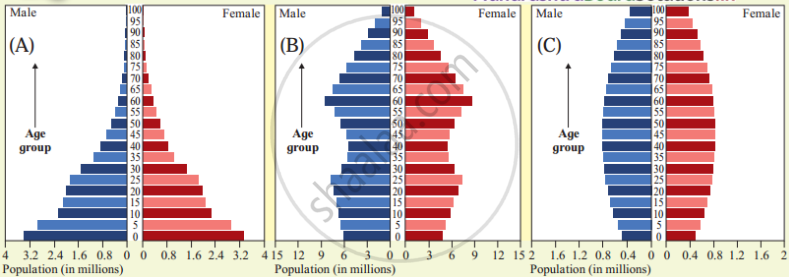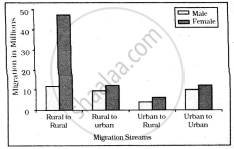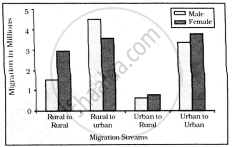Advertisements
Advertisements
प्रश्न
What do you understand by population composition?
उत्तर
People of any country are diverse in many respects. Each person is unique in his own way. People can be distinguished by their age, sex and their place of residence. The entire gamut of people residing in a particular place along with their growth, distribution and variety may be termed as its population composition.
APPEARS IN
संबंधित प्रश्न
Identify the correct co-relation :
A: Assertion; R: Reasoning
A: In the population pyramid, a broad base indicates a high number of children in a country.
R: Broad apex is an indicator of the high number of elderly in a country
Write a short note on literacy rate.
Give a geographical reason:
In developed countries, the percentage of the population engaged in agriculture is low.
Give a geographical reason:
Demographic dividend increases when the proportion of the working population increases.
Broad base with narrowing apex shows that more people die at each higher band. It shows ______.
Assertion: The working population classified according to occupations is known as occupational structure.
Reason: Occupational structure indicates development of a country.
Identify the incorrect factor
Difference in population according to rural-urban structure:
Identify the incorrect factor
Factors having direct relation with literacy:
Observe the following graph and answer the question given below:

Questions:
- Which pyramid(s) represent(s) a country with high medical expenditure?
- Which pyramid(s) represent(s) a country with a large manpower?
- In which pyramid(s) the number of old people will be the least?
- What is the reason of the broad shape of A pyramid?
- Why C pyramid looks vertical in shape?
Observe the following graph and answer the question given below

Question:
- Which region has the highest literacy rate?
- Which region has the lowest literacy rate?
- In which region does women fare better than men in literacy rate?
- Write a concluding paragraph about the graph.
- Which is the type of graph?
Write short note
Population pyramid and sex ratio
Why do some states of India have higher rates of work participation than others?
Which one of the following countries has the highest sex ratio in the world?
Why have many European countries have deficit males?
Why is an unfavorable female sex ratio found in India and other South Asian countries?
How is sex ratio calculated in different countries of the world?
Why is the age structure considered an important indicator of population composition? Give one reason.
“In some countries of the world, the sex ratio is unfavourable to women.” Give one reason.
“In some countries of the world, the sex ratio is unfavourable to women.” Give one reason.
Describe the main characteristics of each of the major groups of human occupations in the world.
How many Million Plus towns are there in India (in 2001)?
The literacy rate in India is ______.
How many scheduled languages are in our constitution?
A worker is known as main worker, who works atleast ____________.
Which one of the following country has highest sex ratio in the world?
Which one of the following reflected by Age-Sex pyramid?
Which attribute does not distinguish people?
In European countries, a deficit of males is due to ______.
The aging population has aged more than ______.
According to the UNO, how many countries have sex ratio unfavourable for females?
Which of the following programs sponsored by the central government aims at enabling the rural population to conserve water for drinking, irrigation, fisheries and afforestation?
Population of India according to Occupation can be categorized into:
Study the given graph carefully and answer the following question:

Intra-state Migration by place of Last Residence Indicating Migration Streams India, 2011

Inter-state Migration by Place of Last Residence Indicating Migration Streams India, 2011
What is the main cause of male migration from rural to urban?
Table: India-Class-wise number of towns and cities and their population, 2011
| Class | Population Size | Number of Cities | Total Urban Population (in thousands) | % of Total Urban Population |
| I | 1,00,000 & more | 568 | 2,27,899 | 60-45 |
| II | 50,000-99,999 | 474 | 41,328 | 10-96 |
| III | 20,000-49,999 | 1,373 | 58,174 | 15-43 |
| IV | 10,000-19,999 | 1,683 | 31,866 | 8-45 |
| V | 5,000-9,999 | 1,749 | 15,883 | 4-21 |
| VI | less than 5,000 | 424 | 1,956 | 0-52 |
Source: Census of India-2011 and India 2017, Ministry of Information and Broadcasting, Government of India.
Which class town has the maximum urban population?
The significance of age-structure is/are?
The sex ratio in a country can be expressed as which of the following?
Which of the following is not a reason of unfavourable sex ratio against women?
Consider the following statements and choose the ones which are correct.
- The world population on an average shows a sex ratio of 102 males per 100 females.
- According to UN, there are only 72 countries that have a favourable sex ratio for females.
- The sex ratio is lowest in Qatar.
Which group is also known as post-reproductive group?
Mining is a ______.
Arrange according to increase in age :
- Adults
- Children
- Old people
- Young people
Assertion: India is agrarian country.
Reason: Population engaged in agriculture is high in India.
Draw neat, labelled diagram:
Stationary pyramids
Which one of the following is the largest linguistic group of India?
Which one of the following is the largest linguistic group of India?
Which one of the following is the largest linguistic group of India?
Read the following graph and answer the questions given below:

Questions:
- Which region has a very less adult female literacy rate?
- Why the percentage of adult male literacy rate is more in the given regions?
- Why the percentage of female-male literacy rate in 2016 is less in sub-Saharan Africa?
- Write your own opinion about the adult female literacy rate with reference to the graph.
- With reference to graph which country would be advanced in social factors?
Which one of the following is the largest linguistic group of India?
Which one of the following is the largest linguistic group of India?
Which one of the following is the largest linguistic group of India?
